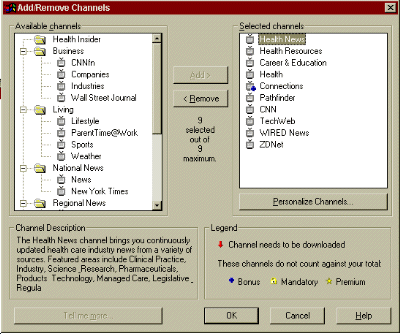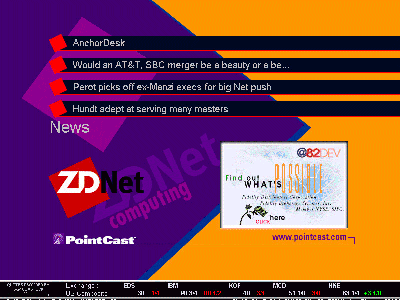 What is the "Push"
What is the "Push"Technology






 What is the "Push"
What is the "Push"[ How it Works
| In Medical Publications | To Know
More | The Author ]
Five thousand years ago, with the invention of writing, the human species took its first jump towards a technological civilization. The second one came only in the second half of the XV century, with the invention of the printing press, by Johannes Gutenberg. The possibility of reproducing thousands of identical copies of the same document led to the creation of the first newspapers, magazines and journals, a revolutionary concept. But this ocurred in a very slow and graded way: the first printed scientific journal, for example, was released in 1665, almost 200 years after Gutenberg's invention. However, they are, until today, the basis of a huge system of dissemination in science and technology, counting with more than 300,000 journals and magazines around the world, and which has changed very little in the last three centuries.
Nowadays, this scenario is about to change radically, with the development of global computer networks, such as Internet, mainly after the explosion of WWW (World Wide Web), that allows for high quality electronic publishing, with texts, images, videos, etc. Together, these two technologies have a revolutionary potential many times superior than that of the invention of the press.
WWW is based on an active model of search for information, which, in the traditional Internet navigation mode, is called “pull” technology. The user obtains information from different WWW sites, searching for topics of his interest. The huge volume of documents and sites available today makes possible the acquisition of the right kind of information only after a refined search procedure, made with one of the mechanisms in existence for this purpose. The whole process is increasingly difficult and time-consuming. Besides that, the continous growth of available information and the necessity of individually visiting the sites is, slowly, making access unfeasible, both from the user’s and the publisher’s points of view.
The traditional information media are based on a passive model, that is, the subscriber receives information through a “broadcasting” or transmission system (newspapers, magazines, radio and TV). In Internet this technology already exists, and it's denominated “push”, also known by the names of “webcasting” and “pointcasting”. The solution given by the rise of “push” technology inverts this equation, allowing Internet to directly reach the final user, and delivering information based on a pre-defined interests profile and eliminating the search and selection steps.
 How
it Works
How
it WorksThe system is constituted, on the subscriber's side, by a specialized browser that uses the same basic TCP/IP communication protocol used in the Internet, and that receives multimedia material from a specialized transmitting agency (the server)

PointCast's specialized browser access screen.
The essential actors of a “push” system are the service subscribers (users who have access to the Internet and who subscribe to the service channels), the authors and publishers (content creators) and the vendors (who create and sell client/server applications for publishers and subscribers to use). Among the main commercial providers today there are PointCast, Marimba, Netscape e Microsoft (see addresses at the end of the article). In the non-scientific field, the information supply model is that of free-of-charge access. The bill is paid by advertisers, who are able to insert an animated advertisement in one of the browser's window, which is usually linked to their Internet sites .
The fast dissemination of “push” technology in Internet has lead to numerous organizational initiatives, such as the Push Council. It is estimated that about 10% of the daily Internet traffic worldwide is due to “push” technology (PointCast had more than 2 million users around January 1998). Specialized analysts are unanimous in saying that this will be the area in Internet that will show the highest growth rates in the near future.
Each push server offers several information
multimedia channels, among them news, entertainment, sports, health and
business channels, etc. The program user sets up the channels of his/her
interest and receives information according to his/her choice, with periodic
updates. Channels can transmit plain text, HTML pages, Java applets, images,
videos, sounds or any type of digitized media. The update frequency can
be set up by the user and can be continous or periodic, or under demand.
The server stores a profile of interests and options for that particular
user and sends (“pushes”) the new material available since the last emission,
which is kept in the client’s disk, for later access. Thus it works very
much like electronic mail (email), the oldest of "push" technologies
around.

Channel selection screen in PointCast software for content personalization received by user.
In “push” technology, the information is transmitted in packets, which exist in many formats. The industry future depends on the success of creating a standard format for all software. The client software is usually in the public domain and it's freely distributed. Nowadays, it is possible to use generic browsers (Internet Explorer, Netscape) to access “push” channels, but usually a specialized client is used, such as PointCast, Marimba, BackWeb, etc. In order to implement a “push” service, the information provider needs to install a specific server software, that works together with the client (for example, Castanet is the server name that works with Marimba).

Dynamic PointCast screen, which substitutes the screensaver.
 "Push" Technology in Medical Publications
"Push" Technology in Medical PublicationsA good example is the abridged health news system created by the Johns Hopkins University, in Baltimore, USA, one of the most famous in the world. Named InteliHealth, the system combines all of the above technologies: it has a traditional WWW site, updated daily with health and Medicine news, captured by news agencies, such as Reuters, CNN, Associated Press, etc, or abridged from recently publicated articles in journals such as the New England Journal of Medicine, Lancet, Nature Medicine, etc. Besides that, in association with PointCast, the user can choose the health news channels he/she desires, which include: professional career (jobs openings, conferences calls), continued medical education, news about drugs, the medical device industry, health administration systems, public health, medical news for consumers, etc. Some of these channels have subdivisions, which the user must specify. Finally, the user can also subscribe to a mailing list, thus receiving a summary of the main medical news every day. Both in the email and in the PointCast versions, there are WWW addresses that contain the news in a more extensive form, so that the user can access it, if desired.
Recently, PointCast has launched ten specialized servers dedicated to vertical industry segments, one of them being health and medicine. The specialized client can be downloaded free of charge from http://www.pointcast. com.
In this way, a new high impact communication form is arising, at the same time taking advantage of all multimedia resources available in the Internet with the certainty that the information is delivered to the correct user and according to a desired interest profile. In the near future, the integration of “push” technology with traditional media like television, cinema and radio will be possible, changing radically not only the mass media, but also the realated business and marketing strategies involved.
Finally, the use of information technologies based in Artificial Intelligence will be increasingly used in order to improve access to information filters both in the client's and in the server's side. Sofware "robots" and other autonomous agents will get and send to the subscriber’s computer only those news and articles which satisfy highly specific interest criteria.
 To
Know More
To
Know More The
Author
The
Author Marcelo
Sabbatini is graduating in Scientific Communications by the São
Paulo Methodist University and is the general coordinator of e*pub:
the Group of Electronic Publications in Medicine and Biology of the
Center for Biomedical Informatics
of the State University of Campinas, Brazil.
Marcelo
Sabbatini is graduating in Scientific Communications by the São
Paulo Methodist University and is the general coordinator of e*pub:
the Group of Electronic Publications in Medicine and Biology of the
Center for Biomedical Informatics
of the State University of Campinas, Brazil.
Published
by:

Center for Biomedical Informatics State University of Campinas, Brazil © 1997 Renato M.E. Sabbatini |
Sponsored
by:

Searle Brazil |